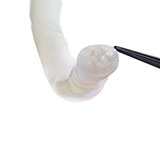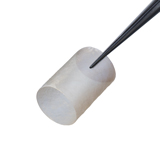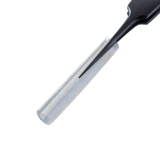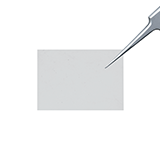mandible resection procedures
Reconstructing and repairing the inferior alveolar nerve (IAN) at the time of mandibular resection is more likely to help patients achieve full functional outcomes and improved quality of life.1-3 Timing matters, because patients with persistent neurosensory disturbances after IAN damage consistently report reduced quality of life related to their injuries.4-6
Contemporary management of ablative jaw defects includes not only hard and soft tissue reconstruction, but also restoration of neurosensory function. Connector-Assisted Repair® with Avance® Nerve Graft and Axoguard Nerve Connector® has demonstrated meaningful recovery rates† of 89% when used for IAN repair, without the comorbidities commonly associated with autograft.7
remember the following:
- According to AAOMS ParCar guidelines, consideration should be given toward neural reconstruction following ablative jaw procedures that result in nerve continuity defects, using interposition autogenous or allogeneic nerve grafting.8
- When a nerve gap is created upon tumor excision, Avance Nerve Graft can be used to bridge a gap up to 7 cm with Connector-Assisted Repair.9
- A Connector-Assisted Repair at the proximal and distal coaptations using a semi-translucent, porcine, small intestine submucosa (SIS) Axoguard Nerve Connector may enable easier coaptation, reduce tension and improve fascicular alignment.7
- The construct can be wrapped with an Axoguard Nerve Protector® to provide a physical barrier between the nerve and the surrounding bone, hardware and tissue.
publications
solutions
 Avance® Nerve Graft
Avance® Nerve Graft  Axoguard Nerve Connector®
Axoguard Nerve Connector®  Axoguard Nerve Protector®
Axoguard Nerve Protector®  Axoguard HA+TM Nerve Protector See sizing and IFU on solution pages
Axoguard HA+TM Nerve Protector See sizing and IFU on solution pages more procedures
There’s only a short form between you and our nerve product team who can help you get more information about our nerve repair solutions.
Sign up for our newsletter to get the latest research, news and in-depth insights about nerve repair.
references
†Defined as Medical Research Council Scale of S3/M3 or greater.
- Ducic I, et al. Reconstructive options for inferior alveolar and lingual nerve injuries after dental and oral surgery. Ann Plast Surg. 2019;82(6):653-660.
- Salomon D, et al. Outcomes of immediate allograft reconstruction of long span defects of the inferior alveolar nerve. J Oral Maxillofac Surg. 2016;0278-2391/16/30251-8.
- Akbari M, et al. The inferior alveolar nerve: to graft or not to graft in ablative mandibular resection? J Oral Maxillofac Surg. 2019;77(6):1280-1285.
- Cakir M, et al. Effects of inferior alveolar nerve neurosensory deficits on quality of life. Niger J Clin Pract. 2018;21:206-211.
- Patel N, et al. Quality of life following injury to the inferior dental or lingual nerve—a crosssectional mixed-methods study. Oral Surg. 2018;11:(1)9-16.
- Leung YY, et al. Trigeminal neurosensory deficit and patient reported outcome measures: the effect on life satisfaction and depression symptoms. PLoS One. 2013;8(8):e72891.
- Zuniga J, et al. A case-and-control, multisite, positive controlled, prospective study of the safety and effectiveness of immediate inferior alveolar nerve processed nerve allograft reconstruction with ablation of the mandible for benign pathology. J Oral Maxillofac Surg. 2017;75(12):2669-2681.
- American Association of Oral and Maxillofacial Surgeons (AAOMS). Parameters of care: AAOMS clinical practice guidelines for oral and maxillofacial surgery (AAOMS ParCare). 6th ed. 2017:e207.
- Miloro M, et al. Virtual surgical planning for inferior alveolar nerve reconstruction. J Oral Maxillofac Surg. 2017;75(11):2442-2448.